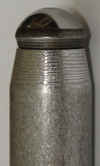The stiffer the better
 Up until about five years ago, the standard pushrod outside diameter for a USAC National midget engine was 5/16 inch, costing roughly $6 each. That has changed, according to Frank Honsowetz of Ed Pink Racing Engines (EPRE). Now, he uses one of two Trend 4130 chrome moly pushrod specifications, both with carbo-nitriding that infuses carbon into the material for a better bearing surface.
Up until about five years ago, the standard pushrod outside diameter for a USAC National midget engine was 5/16 inch, costing roughly $6 each. That has changed, according to Frank Honsowetz of Ed Pink Racing Engines (EPRE). Now, he uses one of two Trend 4130 chrome moly pushrod specifications, both with carbo-nitriding that infuses carbon into the material for a better bearing surface.
Honsowetz said the 166-cubic-inch Toyota four-cylinder engine they build for use in USAC’s National midget competition requires a stable valve train – something that’s inherently tough to achieve. For that reason, he has progressed from the 5/16 (with 0.080 wall) to using either of two specifications: 7/16-inch double taper pushrod with 0.165 wall thickness (at a cost of about $16 each) or 9/16 full taper with 0.188 wall thickness, costing him roughly $33 each.
“The ultimate thing we’re looking for is thickness of the pushrod – but we can’t have it too thick that it touches anything.” For that reason, they use the double taper pushrod in most of its engines, a unit that tapers from centre to either end. This specification keeps the material away from other vital parts of the engine.
“The smaller, 7/16-inch pushrod works for the application in many instances and it is the pushrod we have been using since the start of the Toyota programme in 2006. The National midget engine has more stress to it (than, say, the Silver Crown eight-cylinder) and, bottom line, we use both the 7/16 and 9/16 pushrods; it all depends on the track and the stress on the engine.
“For instance,” Honsowetz continued, “With a heavy duty-cycle, we might go for a stronger pushrod,” even though such usage requires cylinder head adaptation. “When we really have to lean on the engine at Phoenix International Raceway, Iowa Speedway and Belleville – those would be the three hardest tracks on the Toyota midget engine – we’d likely adapt the cylinder head to use the stronger, thicker pushrod,” that is, one that has a full taper.
“If we are leaning on the engine and running higher revs (upwards of 9200 rpm), we want to go for the thicker, stronger pushrod. We’ll then make adjustments to the cylinder head wall in order to accommodate it.” This engine builder has been using the 9/16 full taper pushrod for about 2-3 years: “We use a mix of pushrod sizes, but it’s certainly not a 50-50 mix,” Honsowetz told me.
Weight isn’t much of an issue with the pushrods. The older 5/16 weighs all of 55 grams, while the 7/16 goes off at 112 grams and the larger, 9/16 diameter pushrod weighs 160 grams. “We don’t worry about the weight of the pushrod,” Honsowetz allowed. “We are mostly concerned with stiffness.”
The pushrods used in the Toyota engine “get cycled in and out, but they all go through a magnaflux check,” he said. “Each is numbered and checked and we actually use them for quite a long time. They do get changed during rebuilds because there is machining of components associated with the pushrod.” Honsowetz said that, with his stiffer valve train he has no oiling problems. “It’s not something we worry about.”
Written by Anne Proffit.